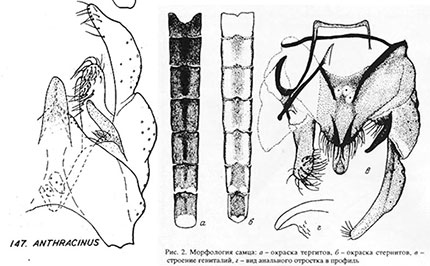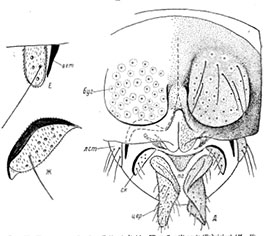Species q. C. anthracinus Zetterstedt |
| | ||||||||||

Male hypopygium of Chironomus anthracinus (from Townes 1945)(left) and of Palearctic specimen (from Shobanov (1996)(right).
From the illustrations it appears there are 3-6 setae in about 3 compact pale areas on TIX. The anal point and appendages unusually short and broad. SV as illustrated by Townes (1945) does not exactly fit any of Strenzke's types, although it is essentially an E-type. It differs from that of Palearctic specimens as described by Shobanov (1996) (above). Inferior volsella longer than anal point and to about the midpoint of the gonostylus, which is quite swollen and narrows sharply over distal 1/3.
Female:
Thoracic setae: acrostichal 18-33; dorsocentral 50-65; prealar 8-12; supraalar 1-2; scutellar about 55 in 3 irregular rows.
The ventral terminalia are illustrated (below):

Ventral view of the terminalia of C. anthracinus (Rodova 1978)
Pupa: Based on Langton & Visser (2003): Length 10.3-13.7 mm.; wing 2.27-2.66 mm.
Cephalothorax dark brown, abdomen colorless with restricted brownish or golden markings.
Cephalic tubercles conical 125-200 x 100-157 µm. Basal ring 155-157 x 55-70 µm. Hook row of segment II entire, occupying 0.54 of segment width and with 87-131 hooks. Shagreen an undivided, moderately extensive patch of strong points, but but more or less reduced on seg.VI. Spur of segment VIII with about 3-6 spines. Anal fringe of 119-159 taeniae.
Fourth instar larva a medium to large thummi-type larva (12.4-20.2 mm) with anterior pair of ventral tubules normally longer (Ant. 1.0-1.9 mm; Post. 0.73-2.44 mm); one larva had a small lateral tubule about 20 µm long. Oesophageal opening about 81-91 x 25 µm, 3.2-3.6 times longer than wide. Anal tubules about 340-520, but up to 1240 µm long, usually simple but the longest one with a median constriction, 2.9-4.3 times longer than wide.
Ventral head length about 410 µm (female), 385 µm (male). Gular region dark over at least the posterior two thirds and commonly right up to the base of the mentum; frontoclypeus pale.
Mentum (Fig. c) width about 250 micron (female), 235 micron (male), about 0.6 of VHL; with a broad c1 tooth, c2 teeth sometimes clearly on shoulders of c1, but in other specimens may be almost distinct teeth (Type II-II). Fourth lateral teeth reduced to height of 5th laterals (Type II-III).
Ventromental plates (Fig. d) about 246-250 µm wide and 3.5 times wider than deep, slightly wider than the mentum (1.01-1.03), with about 38-42 striae reaching 2/3 of way to anterior margin and reaching closer towards the lateral edge; IPD about 40% of mentum width, with about 37-47 striae.Pecten epipharyngis (Fig. a) with about 12-17 teeth of type B, but a few may be reduced.
Premandible with outer tooth broad, about 3.5-3.8 times wider than the moderately broad outer tooth.
Antenna (Fig. b) with relatively long basal segment, about 0.35 of Ventral head length and 2.7-3.9 times as long as broad; ring organ abt. one third to a half up from the base; AR about 1.8-2.1; antennal segments 150 : 39 : 11 : 16 : 8 micron.
Distance between antennal bases greater than distance between the S4 setae, which are separated by about 0.85-0.87 of the frontoclypeus width. S5 setae about level with the nearby RO.Mandible (Fig. e) about 340 µm long, of type II-IIIB; about 16-20 furrows on outer surface near base, 14-15 taeniae in Pecten mandibularis; Mdt-Mat 30-33 µm., MTR 0.29-0.34.
Two specimens from Friebauer Lake, Wisconsin differ in three respects - they possess lateral tubules about 360 micron in length, the posterior VT are longer than the anterior, and the frontoclypeus is darkened. The significance of these differences is uncertain.
Cytology: 4 relatively short polytene chromosomes with the thummi arm combination AB, CD, EF, G.
Arm G unpaired and cloudlike with only one or two clear bands and a nucleolus. Arm F with a median nucleolus in group 9.
Polymorphism occurs in arm A and D. See also C. rempeli (sp. 2m), which may be a synonym. Some larvae have arm F with one or two heterochromatic knobs (F1k and F1kk), but whether such knobs are sex linked as in C. rempeli has not been determined, and hence there is uncertainty as to the synonymy.
h'ant A1: 1 - 2c, 10 - 12a, 13ba, 4a-c, 2g-d, 9 - 4d, 2h - 3, 12cb, 13c - 19 i.e. as plumosus2
h'ant A2: 1 - 2c, 10 - 12a, 13ba, 3f - 2h, 4d - 9, 2d-g, 4c-a, 3g-i, 12cb, 13c - 19
n'ant A3: 1 - 2c, 9a-e, 2d-g, 4c-a, 13ab, 12a - 10, 8a - 4d, 2h - 3i, 13c - 19 (heterozygote only, in C. rempeli?)
h'ant B1: Not mapped. No obvious puff
h'ant C1: 1 - 6b, 11c - 8, 15 - 11d, 6gh, 17a - 16, 7d - 6c, 17b - 22
n'ant Cx: not mapped. (heterozygote only)
h'ant D1: 1-3, 14g-16, 8c-7g, 5d-7f, 18d-17, 8d-10a, 13a-11, 14f-13b, 10b-e, 4-5c, 18e-24
h'ant D3: 1-3g, 14g-16, 8c-7g, 18a-d, 7f-5d, 17f-a, 8d-10a, 13a-11, 14f-13b, 10b-e, 4-5c, 18e-24 (in C. rempeli only?)
h'ant E1: 1 - 3e, 5a - 10b, 4 - 3f, 10c - 13 i.e. as cingulatus, etc.
h'ant F1: 1 - 8e, 9c - 23
n'ant F3: 1 - 8e, 9c-e, 14h - 10, 15 - 23 (in C. rempeli only?)
Found: Alberta - ¿Lake Amisk (Kiknadze et al. (2005).
Manitoba - ¿Baptist Lake (Kiknadze et al. (2005); ¿Lake Winnipeg (Sæther 2012).
Ontario - Bat Lake (45.577°N, 78.523°W), Algonquin Provincial Park; Raft Lake (46.42°N, 80.95°W), Hannah Lake
(46.45°N, 81.05°W), Pine Lake (46.38°N, 81.03°W), Ramsey Lake (46.47°N, 81.05°W), Silver Lake (46.47°N, 80.95°W), all Sudbury.
Quebec - Osisko Lake (48.25°N,79.00°W), Lake Arnoux (48.15°N, 79.33°W), both Rouyn-Noranda, Quebec City.
California - Riverside, Riverside Co.
Indiana - Crooked Lake.
New Hampshire - Mirror Lake, Grafton Co.
Wisconsin - Pine Lake, Oneida Co.
Found in lakes.
Karyotype described by Kiknadze, Wuelker, Istomina and Andreeva (2005), but some rare sequences from Canada may apply only to C. rempelii.
Molecular data suggests that two species are included amongst North American material, one of which corresponds to the Palearctic species. The status of the second type is currently unclear. It may correspond to C. rempelii, but unfortuately no material from larvae with the likely C. rempelii sequences have been available for molecular analysis.
There are differences in the description of the larval type in the literature: Shobanov (1966) illustrates the Palearctic larva as a bathophilus-type, while the Nearctic specimens are a thummi-type larva, and there are reports of a C. anthracinus adult emerging from thummi-type larva in England. This may reflect a polymorphism for lateral tubule presence or it may be that some specimens, lacking cytological or barcode confirmation, are another member of the C. anthracinus-group. Larger specimens, with posterior VT longer, may be C. nr. anthracinus (Species 3c).
Modified: 17 April 2021
Access: Unrestricted
Copyright © 2000-2021, Jon Martin.